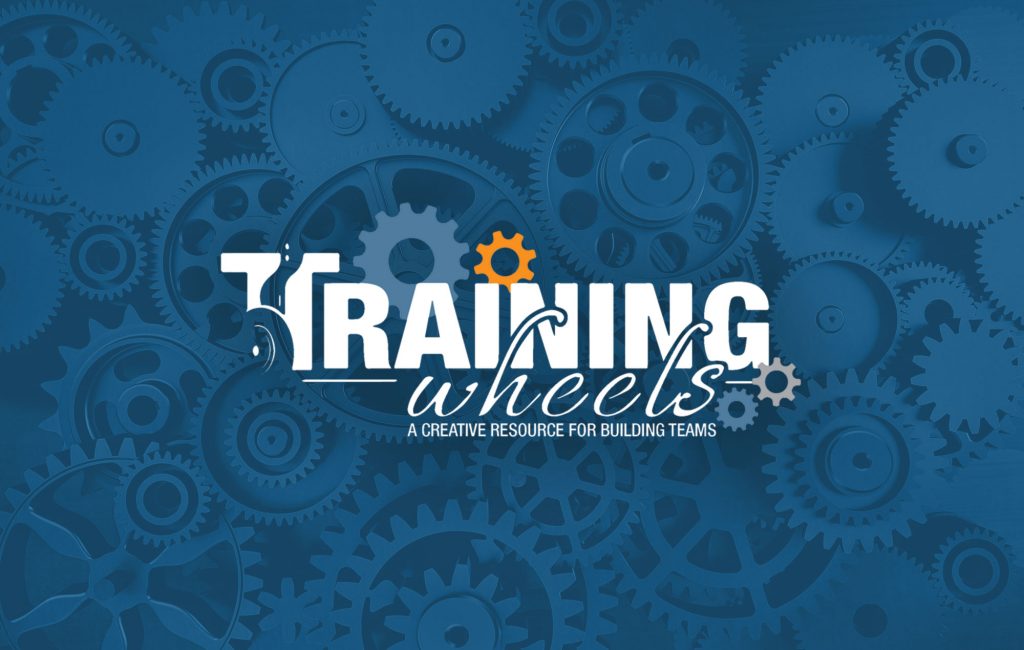
Here’s a link to Chris’ full write up for the Activity shown in the Part 2 Video on the Fundoing Blog.
Here’s how I like to use the Handshake activity, complete with a suggested Facilitator Script!
Activity Directions
Three handshakes and related discussion questions:
 Lumberjack handshake: Begin by giving a ‘thumbs up’ sign with your left hand. Your partner will grab your thumb with their forefingers and give a ‘thumbs up’ sign with their thumb. Repeat this process until all four hands are in this position. (See picture) Utilizing the same movement as a single jack lumber saw, pretend to saw a log together. Move your arms back and forth saying each others’ names gruffly, in a deep lumberjack voice (Michelle, Peter, Michelle, Peter).
Lumberjack handshake: Begin by giving a ‘thumbs up’ sign with your left hand. Your partner will grab your thumb with their forefingers and give a ‘thumbs up’ sign with their thumb. Repeat this process until all four hands are in this position. (See picture) Utilizing the same movement as a single jack lumber saw, pretend to saw a log together. Move your arms back and forth saying each others’ names gruffly, in a deep lumberjack voice (Michelle, Peter, Michelle, Peter).
Lumberjack handshake icebreaker discussion question: “Discuss with your Lumberjack handshake partner something you are looking forward to in today’s program.”
 Salmon handshake: Align your arms with your partner in a ‘zipper’ fashion. (See picture) The palms of your hands should be aligned with the forearms of your partner. Gently slap your hands back and forth against your partner’s forearms, duplicating the sound of the salmon tails slapping against one another.
Salmon handshake: Align your arms with your partner in a ‘zipper’ fashion. (See picture) The palms of your hands should be aligned with the forearms of your partner. Gently slap your hands back and forth against your partner’s forearms, duplicating the sound of the salmon tails slapping against one another.
Salmon handshake icebreaker discussion question: “The plight of the salmon includes a challenging swim upstream. Discuss with your Salmon handshake partner something that challenges you in your current role.”
 Cow handshake: One person will create udders with their hands. This person will need to lace their fingers together with their thumbs pointing up and as far apart as possible. They will then invert their hands so that the thumbs now point down creating the udders of the cow. (See picture) The other partner will pretend to milk the cow by alternately squeezing their partners’ downward pointing thumbs.
Cow handshake: One person will create udders with their hands. This person will need to lace their fingers together with their thumbs pointing up and as far apart as possible. They will then invert their hands so that the thumbs now point down creating the udders of the cow. (See picture) The other partner will pretend to milk the cow by alternately squeezing their partners’ downward pointing thumbs.
Cow handshake icebreaker discussion question: “How many people did I just push outside your comfort zone? Raise your hand to elicit a response from the group. “As leaders we often have our comfort zone boundaries pushed. Discuss with your Cow handshake partner something that pushes you outside your comfort zone in your current role.”
Facilitator Script
“I once got a call from a lumberjack convention to come and facilitate a few name games and icebreakers. When I arrived at registration, people were greeting each other a strange way that I had not seen before. Now being the curious, extroverted type I asked, “What was that?” They replied, “That’s the lumberjack handshake, you’ve never seen it before?” I replied, “No, will you teach it to me?” Begin demonstration of how to execute the lumberjack handshake. “You begin by giving a ‘thumbs up’, then your partner grabs your thumb, then you grab their thumb, and finally they grab your thumb. Then together you pretend to saw a log and say your names together ‘Lumberjack style’. Michelle, Peter, Michelle, Peter. Go ahead and greet your Lumberjack Handshake partner!”
Once the group has performed this handshake get their attention and give them the related discussion question. “Great job! Now please take two minutes and discuss with your Lumberjack partner one thing you enjoy about being a leader in your organization.”
Allow for 2 minutes of discussion, then get the groups attention.
“OK, I want you to remember who your Lumberjack handshake partner is and say ‘Adios Amigos’ and then find a new partner. I will teach you a new handshake with this new partner.”
Once everyone has found a new partner begin the second handshake sequence.
“That lumberjack convention was up in Canada, so while I was that far north I decided to take a little time off and fly over to Alaska to take in some fly fishing. I hired a guide for the day and he must have been very well known in the area, as people kept coming up to him and greeting him a strange way that I had never seen before. Now being the curious, extroverted type I asked, “What was that?” He replied, “Oh this is the Alaskan Salmon handshake, you’ve never seen it before?” I replied, “No, will you teach it to me?” Begin demonstration of how to execute the salmon handshake. “You begin by extending your arms straight out across from your partner, alternating your arms like a ‘zipper’. Make sure you roll your sleeves up because the sound effects on this one are fun. Then the tails of the salmon gently slap back and forth with one another. Go ahead and greet your salmon handshake partner!”
Once the group has performed this handshake get their attention and give them the related discussion question. “Great job! Now the plight of the salmon includes a challenging swim upstream. Discuss with your Salmon handshake partner something that challenges you in your current leadership role.”
Allow for 2 minutes of discussion, then get the groups attention.
“OK, I want you to remember who your Salmon handshake partner is and say ‘Hasta la vista’ and then find a new partner. I will teach you a new handshake with this new partner.”
Once everyone has found a new partner begin the third handshake sequence.
“I finally got back from this crazy trip I’ve been on, and I had a job interview with a potential new hire the first day back in the office. When he arrived for his interview I stuck out my hand to greet him and he did this.” Demonstrate the udder hand position. “Being the curious, extroverted type I asked, “What is that?” He replied, “Well I’m from Wisconsin and Wisconsin is famous for what?” “Cheese” “And cheese comes from what?” ‘Cows!” “This is the Wisconsin cow handshake where one person makes the udders and the other person milks the udders.” This usually elicits some “Ews!” and laughter from the participants. “Go ahead and greet your cow handshake partner.”
Once the group has performed this handshake get their attention and give them the related discussion question. “Great job! “OK, out of curiosity, how many people did I just push outside of your comfort zone?” Raise your hand to elicit a response from the group. “As leaders we often have our comfort zone boundaries pushed. Discuss with your Cow handshake partner something that pushes you outside your comfort zone in your current leadership role.”
Allow for 2 minutes of discussion, then get the groups attention.
“OK, we are now going to do a quick ‘Handshake Frenzy’. What I mean by that is, I’m going to call out the name of a handshake and you need to quickly find the partner you originally did that handshake with and perform that handshake together. Then I will call out the name of a different handshake and you will need to quickly find the partner you originally did that handshake with and perform that handshake together. Now when I say ‘quickly’ and ‘frenzy’ it does not mean you need to body-check people out of the way to find your partner. Just quickly find them, do your handshake and listen for the next handshake to be called. I will give you plenty of time to find and perform your handshake. Any questions? Ok, go and find your Salmon Handshake partner…..”
After all three handshakes have been completed, move along to your next item on your agenda.
Teachable Moments
Copyright Michelle Cummings, Training Wheels.

Founder / Facilitator / Big Wheel of Training Wheels